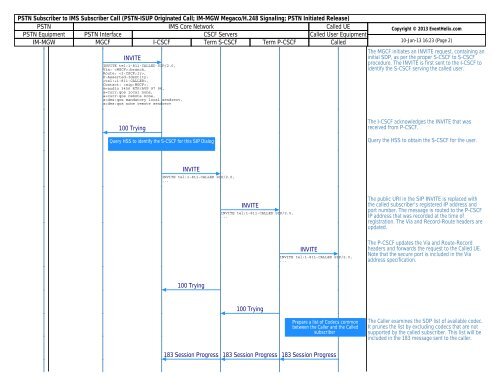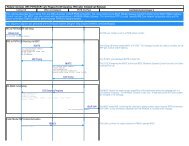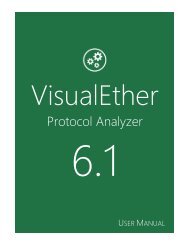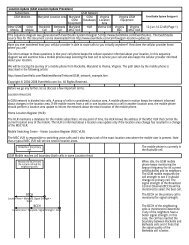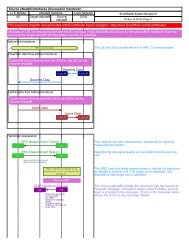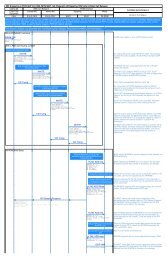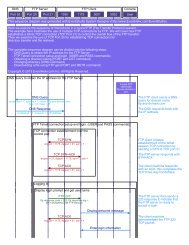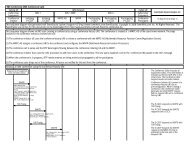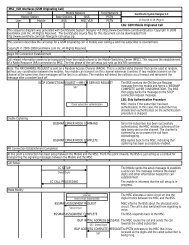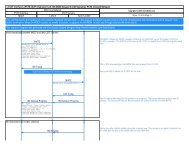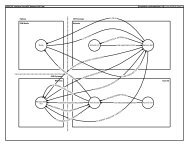PSTN to IMS Call Flow - EventHelix.com
PSTN to IMS Call Flow - EventHelix.com
PSTN to IMS Call Flow - EventHelix.com
You also want an ePaper? Increase the reach of your titles
YUMPU automatically turns print PDFs into web optimized ePapers that Google loves.
<strong>PSTN</strong> Subscriber <strong>to</strong> <strong>IMS</strong> Subscriber <strong>Call</strong> (<strong>PSTN</strong>-ISUP Originated <strong>Call</strong>; IM-MGW Megaco/H.248 Signaling; <strong>PSTN</strong> Initiated Release)<br />
<strong>PSTN</strong> <strong>IMS</strong> Core Network <strong>Call</strong>ed UE<br />
<strong>PSTN</strong> Equipment <strong>PSTN</strong> Interface CSCF Servers <strong>Call</strong>ed User Equipment<br />
IM-MGW MGCF I-CSCF Term S-CSCF Term P-CSCF <strong>Call</strong>ed<br />
INVITE<br />
INVITE tel:1-811-CALLED SIP/2.0,<br />
Via: ;branch,<br />
Route: ,<br />
P-Asserted-Identity:<br />
,<br />
Contact: ,<br />
m=audio 3456 RTP/AVP 97 96,<br />
a=curr:qos local none,<br />
a=curr:qos remote none,<br />
a=des:qos manda<strong>to</strong>ry local sendrecv,<br />
a=des:qos none remote sendrecv<br />
Copyright © 2013 <strong>EventHelix</strong>.<strong>com</strong><br />
10-Jan-13 16:23 (Page 2)<br />
The MGCF initiates an INVITE request, containing an<br />
initial SDP, as per the proper S-CSCF <strong>to</strong> S-CSCF<br />
procedure. The INVITE is first sent <strong>to</strong> the I-CSCF <strong>to</strong><br />
identify the S-CSCF serving the called user.<br />
100 Trying<br />
Query HSS <strong>to</strong> identify the S-CSCF for this SIP Dialog<br />
The I-CSCF acknowledges the INVITE that was<br />
received from P-CSCF.<br />
Query the HSS <strong>to</strong> obtain the S-CSCF for the user.<br />
INVITE<br />
INVITE tel:1-811-CALLED SIP/2.0,<br />
...<br />
INVITE<br />
INVITE tel:1-811-CALLED SIP/2.0,<br />
...<br />
INVITE<br />
INVITE tel:1-811-CALLED SIP/2.0,<br />
...<br />
The public URI in the SIP INVITE is replaced with<br />
the called subscriber's registered IP address and<br />
port number. The message is routed <strong>to</strong> the P-CSCF<br />
IP address that was recorded at the time of<br />
registration. The Via and Record-Route headers are<br />
updated.<br />
The P-CSCF updates the Via and Route-Record<br />
headers and forwards the request <strong>to</strong> the <strong>Call</strong>ed UE.<br />
Note that the secure port is included in the Via<br />
address specification.<br />
100 Trying<br />
100 Trying<br />
Prepare a list of Codecs <strong>com</strong>mon<br />
between the <strong>Call</strong>er and the <strong>Call</strong>ed<br />
subscriber<br />
The <strong>Call</strong>er examines the SDP list of available codec.<br />
It prunes the list by excluding codecs that are not<br />
supported by the called subscriber. This list will be<br />
included in the 183 message sent <strong>to</strong> the caller.<br />
183 Session Progress<br />
183 Session Progress<br />
183 Session Progress


